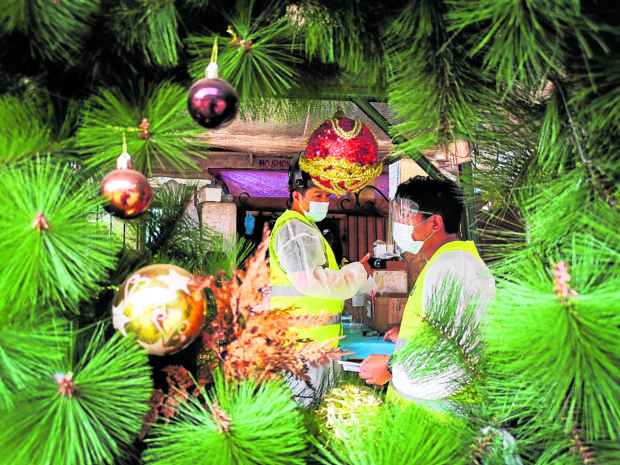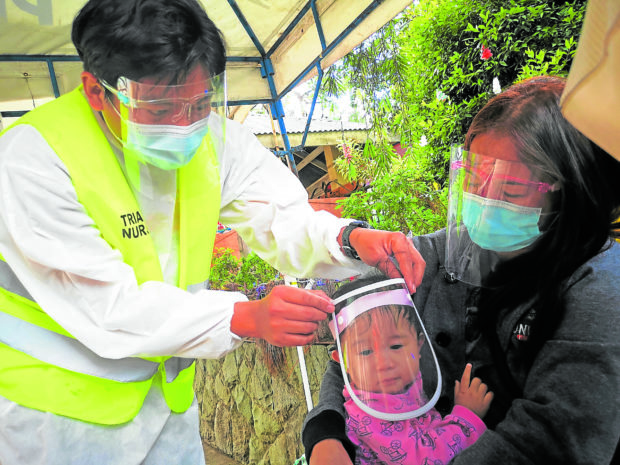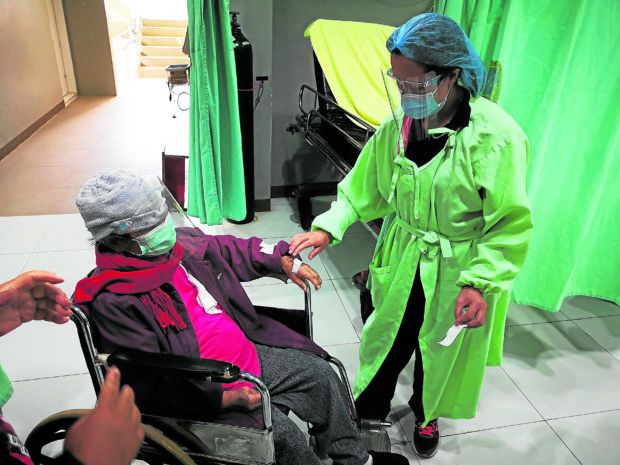Pandemic warriors find healing in community support

NO HOLIDAY BREAK Nurses and doctors work nonstop to treat patients at Baguio General Hospital and Medical Center with Christmas decor as their only reminder about the Yuletide and the coming New Year. —PHOTOS BY EV ESPIRITU
BAGUIO CITY — Nurse Jim Tugay-an was amused by an online meme that promised “positive things will happen to you this week,” followed by a photo of a positive coronavirus test result.
Tugay-an was no longer laughing when he contracted the virus recently, but the affliction gave him a firsthand experience of what more than 3,000 patients in Baguio City had endured since March.
It also gave meaning to the praise and cheers health workers drew during the first week of the pandemic when they were called “heroes,” said Gevelyn Galapon, a staff nurse of St. Louis University (SLU) Sacred Heart Hospital.
Nurses like Tugay-an and Galapon—who fell ill at the front lines while battling the pandemic—shared their stories during a three-day conference of the Philippine Nurses Association (PNA) Cordillera that was live-streamed last week by the University of the Philippines Baguio.
They suffered real depression, burnout, and fatigue like other COVID-19 patients and their inputs should help shape a post-pandemic plan for clinical care, SLU chief nurse Aldren Remon said.
The conference reviewed the policies and societal ills, which either improved or aggravated the workplace condition of nurses and medical personnel during quarantine.
Nurses and other medical health workers have been called “guardians of the people,” or COVID-19 “warriors,” said Dr. Erlinda Castro-Palaganas, PNA Cordillera governor, “but we are tired and some of us have died.”
Winning the battle
Galapon said her ward was the first unit at the SLU hospital to be dedicated to COVID-19 patients. In the first months of the Luzon lockdown, “we had so much support from everybody and we were called health-care heroes,” she said, adding that “we felt like we were winning the battle.”
“We are still learning and adapting to change,” she said. “I have seen COVID-19 patients since the start of the pandemic—from the first confirmed case and after … and I witnessed their suffering and pain.”
According to Galapon, the first patient at the hospital was intubated due to pneumonia, and had almost lost hope because she had to fight the disease all by herself.
“We got through the first wave,” Galapon said, stressing that nurses like her took satisfaction each time a patient recovered and was discharged.
Draining
“However, when Baguio’s enhanced community quarantine was lifted, the number of patients increased, and those coming to the hospital were even sicker than before. This was the start of the real battle,” she said.
“As this pandemic spread and grew stronger, we became battle-worn,” Galapon said, adding that wearing masks each day “became suffocating.”Then the worst happened amid the “draining and endless duties” when she tested positive for the virus in August.

ON CALL Triage nurses continue to attend to emergencies and walk-in patients, including children who needed to be fitted with face shields.
“It was expected because of the nature of my work but I asked, ‘Why too soon?’ I was scared for my family … I’ve had sleepless nights (at the hospital where she was confined) and wept silently when my mom and my son celebrated their birthdays without me,” Galapon said.
She was one of the first health workers to publicly reveal her condition, and the barrage of encouragement and praise for COVID-19 heroes helped her heal and return to work.
It was a similar experience for Rachel Gay Pacial, a professor at the SLU School of Nursing, who learned that she contracted the disease in September shortly after she gave her diabetic father an insulin shot.
Pacial’s father had complained of diarrhea and pain in his joints, and was soon confined for COVID-19. Her mother, husband and two of their three children also caught the virus.
Throughout her 14-day “solitary healing,” Pacial said: “Every single day, I was anxious … I was fearful of the effect on my family. I felt powerless. I experienced stress overload.”
Tugay-an, who takes care of patients with mild symptoms at the community isolation unit of Sto. Niño Hospital, said: “I thought I was doing my job well. Then I became a patient and I realized I was not providing all of the services to which my patients were entitled.”
Red tape
He said he finally understood why some COVID-19 patients become guarded or grumpy. In complete denial when he learned about his condition, Tugay-an said he went through the bureaucratic red tape undergone by all patients.
“When I went to the hospital for laboratory tests, I waited for a long time, and instructions [to patients] were confusing. No wonder patients were angry and hungry, and we nurses used to wonder why,” he said.
“We treat a patient’s ailment and check his vital signs but never ask about his feelings. When we do that, we connect better with patients. We have to be in someone else’s shoes to fully understand what they’re going through. The infection made me a better nurse,” Tugay-an said.
The pandemic also shows flaws in the health-care system, which nurses can help change “through meaningful activism” since they are at the front line of every health emergency, Palaganas said.

BATTLINGCOVID-19 Many Cordillera health workers, who are employed by public and private hospitals or who have been pursuing other careers, are among those manning the front line of the battle against COVID-19 since the pandemic struck in March.
Before the COVID-19 crisis, the government and the private health sector were starting to check a “fragmented” health system after health care was devolved to the local governments in 1991.
Health-care budgets
Until the pandemic struck, budgets for health care did not fulfill the ceiling prescribed by the World Health Organization, according to Carmen Bolinto, president of PNA Baguio chapter.
She said the 2021 health budget had been reduced, “but COVID-19 is still there.” Bolinto said the Department of Health tried to narrow down the inequity in medical staffing as far back as 2018.
For example, the ideal 2018 ratio of one doctor for 800 Filipinos has not been carried out because one doctor still treats 1,500 people, she said.
The ratio for nurses is actually 1 is to 60 when ideally, one nurse should handle only 12 patients at a given moment, Bolinto added.
When supplies of alcohol and personal protective gear like masks disappeared from the shelves, however, nurses stepped up by forming the Cordillera Nurses Brigade to maintain a supply of food, medicine, and safety equipment, she said. INQ
For more news about the novel coronavirus click here.
What you need to know about Coronavirus.
For more information on COVID-19, call the DOH Hotline: (02) 86517800 local 1149/1150.
The Inquirer Foundation supports our healthcare frontliners and is still accepting cash donations to be deposited at Banco de Oro (BDO) current account #007960018860 or donate through PayMaya using this link.